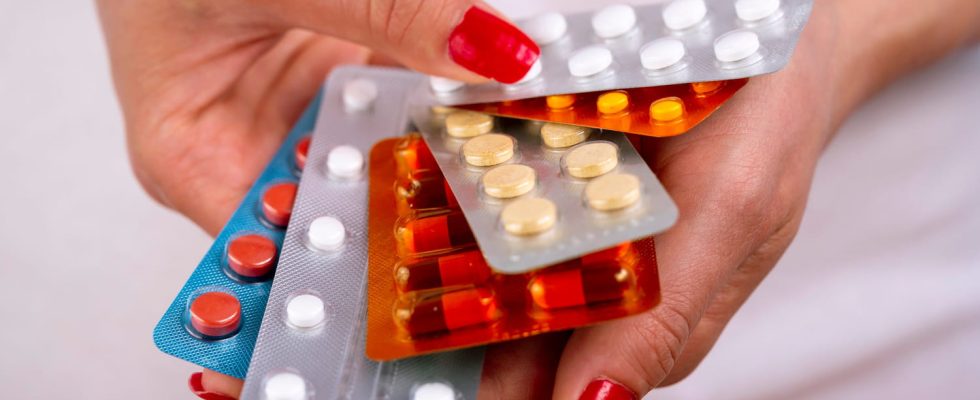Stomach ache, headache, heartburn, wound… Here are the essentials of the first aid kit to relieve the little ailments of everyday life.
1. Paracetamol for fever or headache
The best-selling analgesic molecule in France, paracetamol comes under various trade names: Doliprane®, Dafalgan®, Efferalgan®. It is commonly used for relieve fever and pain such as headaches, painful periods and dental pain. Vigilance is required when medicinal combinations based on paracetamol (Fervex®, Dolirhume®) are administered on the same day since they must be taken into account in the calculation of the daily dose.
2. Ibuprofen, a stronger anti-inflammatory
It’s a Non-steroidal anti-inflammatory drug used to treat pain and fever when the effectiveness of paracetamol proves to be insufficient. It is also possible to take them concomitantly or alternately. To prevent the risk of overdose, it is recommended to respect the maximum daily doses of the two medicinal products and to note the times of administration. Ibuprofen-based medications (Advil®, Nurofen®, Ibupradoll®) have several contraindications and adverse effects to be taken into account.
3. An analgesic cream in case of muscle pain
Analgesic gels, creams and ointments reduce muscle, tendon and ligament pain and trauma benign such as a sprain or a contusion. They contain analgesic compounds: diclofenac (VoltarenActigo®, Flector®), salicylate (Aroma® Balm, Saint-Bernard® balm). A topical is applied in prolonged massage on the painful area, excluding wounds, infected lesions and skin conditions (burns, eczema). Besides, it should not be covered with an occlusive dressing at the risk of inducing an overdose.
4. Spasfon® against stomach ache
It is an antispasmodic drug indicated in the management of pain in the digestive tract, biliary tract, urinary tract (nephritic colitis), female genitalia and pregnancy-related contractions. The administration of Spasfon® (phloroglucinol) is possible in children from 2 years of age.
5. Smecta® to calm diarrhea
Presented in the form of sachets, it is used as digestive dressing to treat acute diarrhea associated or not with intestinal pain. This antidiarrheal should be taken at least two hours apart from other medications. Note that Smecta® (diosmectite) is no longer recommended for children under 2 years of age.
6. Gaviscon® for heartburn
This is a local action antacid taken for gastroesophageal reflux disease manifested by acid reflux and heartburn. This medication contains sodium alginate which forms a foamy gel on the surface of gastric fluid and sodium bicarbonate which neutralizes its acidity. For optimal efficiency, administration should be after meals.
7. A local antiseptic to disinfect a wound
Better known as disinfectanta local antiseptic helps to disinfect a wound to limit the risk of infection. Aqueous chlorhexidine is often used alone with the specialties Septimyl®, Diaseptyl®, Dosiseptine®, or combined with other antiseptics with Biseptin®.
8. An antiseptic mouthwash
This medicine comes in the form of a solution to keep in the mouth for 30 seconds and then spit out. This is particularly the case for Hextril®, Eludril®, Paroex® indicated in the treatment of oral diseases such as inflammation of the gums, an abscess, a sore in the mouth, a mouth ulcer. This type of mouthwash is to distinguish from a daily mouthwash which is not a medicine but a hygiene product used to prevent infections.
9. An ophthalmic wash solution if the eyes are irritated
This type of solution is used in case of eye irritation caused in particular by dust, pollen, secretions linked to conjunctivitis. The instillation of eye drops relieves irritated eyes quickly. The specialties marketed are Dacryoserum®, Dacudoses® and generics based on borax and boric acid.
10. Throat lozenges
Lozenges and lozenges allow you to disinfect the throat with the antiseptic they contain. Some medications only include a local antiseptic such as Strepsils®, Humex sore throat biclotymol®. Other presentations include a local anesthetic in addition to act on the pain: Drill®, Cantalène®, Strepsils lidocaïne®. They are more effective but have precautions for use such as taking them spaced out from meals to avoid a false route and use limited to 5 days to avoid an imbalance of the bacterial oral flora.
What are the self-medication precautions?
► Before using a medicine stored in the family medicine kit, it is essential to check its expiry date and re-read the instructions in case of doubt. Indeed, compliance with the recommended dosages is essential. This is particularly the case for the daily dose of paracetamol which must not exceed 3 grams per day in self-medication.
► If you have any questions, it is best to seek advice from a healthcare professional (doctor or pharmacist) who will be able to identify possible drug interactions and contraindications.
► If you are undergoing treatment or suffer from a chronic illness, self-medication is not recommended. Similarly, if the symptoms persist or worsen after several days, a medical consultation is required.
